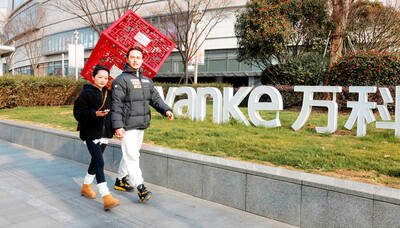Efforts to combine nanotechnology with plasma technology have significantly improved due to new equipment which can produce high-performance carbon nanotubes, the National Science Council said yesterday.
Carbon nanotubes are of intense scientific interest around the world due to their outstanding electrical properties.
These properties make them particularly suitable for building a new generation of flat-screen displays known as field emission displays (FED), council officials said at a press conference.
Council Vice Chairman Chi Gou-chung (紀國鐘) said Taiwan might be able to compete with Japan, South Korea and other countries to try to dominate the future FED market with innovative technologies.
Scientists developing the country's first Inductively-Coupled Plasma Chemical Vapor Deposition (ICP-CVD) demonstrated the carbon nanotubes produced in the lab at the press conference.
According to Tsai Chuen-horng (蔡春鴻), a professor of engineering and system science at National Tsing Hua University, the device can produce the kind of high-performance carbon nanotubes needed for the displays.
The technology used in the device has already received two patents from the government and two more from the US.
"With the equipment, we can grow carbon nanotubes homogeneously on a substrate whose diameter is six inches [15.24cm]," Tsai said.
Tsai said this means Taiwanese scientists will be able to develop core technologies for mass production of FED, which could one day replace liquid-crystal displays (LCD).
According to the Industrial Technology Research Institute, this country will become the largest manufacturer of thin-film transistor liquid-crystal displays in the third quarter of this year, taking about 38 percent of the global market.
Over the past four years, Tsai worked with his colleagues and counterparts from National Tai-wan Normal University, Chung Yuan Christian University, the ITRI and Nano Architect Research Corp (晶研科技), studying the growth mechanism of carbon nanotubes, characteristics of field emission and ICP-CVD.
Tsai said the newly-developed equipment might facilitate the production of state-of-the-art, large-scale video display systems.
National Science Council officials told reporters that the NT$38 million research project has resulted in 112 articles for academic journals and conferences.
They said it might possibly produce as many as 12 patents in Taiwan and the US.

CHIP RACE: Three years of overbroad export controls drove foreign competitors to pursue their own AI chips, and ‘cost US taxpayers billions of dollars,’ Nvidia said China has figured out the US strategy for allowing it to buy Nvidia Corp’s H200s and is rejecting the artificial intelligence (AI) chip in favor of domestically developed semiconductors, White House AI adviser David Sacks said, citing news reports. US President Donald Trump on Monday said that he would allow shipments of Nvidia’s H200 chips to China, part of an administration effort backed by Sacks to challenge Chinese tech champions such as Huawei Technologies Co (華為) by bringing US competition to their home market. On Friday, Sacks signaled that he was uncertain about whether that approach would work. “They’re rejecting our chips,” Sacks

Taiwan’s long-term economic competitiveness will hinge not only on national champions like Taiwan Semiconductor Manufacturing Co. (TSMC, 台積電) but also on the widespread adoption of artificial intelligence (AI) and other emerging technologies, a US-based scholar has said. At a lecture in Taipei on Tuesday, Jeffrey Ding, assistant professor of political science at the George Washington University and author of "Technology and the Rise of Great Powers," argued that historical experience shows that general-purpose technologies (GPTs) — such as electricity, computers and now AI — shape long-term economic advantages through their diffusion across the broader economy. "What really matters is not who pioneers

BUBBLE? Only a handful of companies are seeing rapid revenue growth and higher valuations, and it is not enough to call the AI trend a transformation, an analyst said Artificial intelligence (AI) is entering a more challenging phase next year as companies move beyond experimentation and begin demanding clear financial returns from a technology that has delivered big gains to only a small group of early adopters, PricewaterhouseCoopers (PwC) Taiwan said yesterday. Most organizations have been able to justify AI investments through cost recovery or modest efficiency gains, but few have achieved meaningful revenue growth or long-term competitive advantage, the consultancy said in its 2026 AI Business Predictions report. This growing performance gap is forcing executives to reconsider how AI is deployed across their organizations, it said. “Many companies

China Vanke Co (萬科), China’s last major developer to have so far avoided default amid an unprecedented property crisis, has been left with little time to keep debt failure at bay after creditors spurned its proposal to push back a looming bond payment. Once China’s biggest homebuilder by sales, Vanke failed to obtain sufficient support for its plan to delay paying the 2 billion yuan (US$283.51 million) note due today, a filing to the National Association of Financial Market Institutional Investors showed late on Saturday. The proposal, along with two others on the ballot, would have allowed a one-year extension. All three